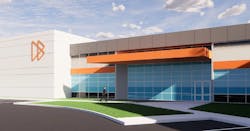DataBank’s Orangeburg Data Center Campus Targets AI for the Empire State
DigitalBridge portfolio company DataBank last month held a dedication ceremony for its new Orangeburg Data Center Campus in New York, celebrating the construction of the site's first data center there, dubbed LGA3.
Orangeburg is 30 miles north of Manhattan and the data center campus is located at 2000 Corporate Drive.
The event marked DataBank's latest IT infrastructure expansion in the rapidly growing New York market to meet the new demand for increased capacity and mission-critical IT infrastructure and services.
"The Town of Orangeburg extends a warm welcome to the inaugural data center on the Orangeburg campus, as it represents a significant milestone in our region's journey towards technological advancement and economic growth," said Teresa Kenney, supervisor of the Town of Orangeburg. "We look forward to a long partnership with DataBank which has already proven to be a responsible corporate citizen in many ways."
The new campus and its first data center is expected to bring jobs, innovation, and economic growth to the region.
"Today marks a pivotal moment for Rockland County as we celebrate the dedication of this cutting-edge data center campus," said Lucy Redzeposki, Rockland County director of Economic Development. "This investment not only brings new jobs and revenue to our community but also solidifies our position as a hub for technological excellence and economic prosperity."
Significantly, construction of the campus directly aligns with the State of New York's Empire AI Consortium, an initiative which endeavors to establish New York as the national leader in AI research and innovation.
The Empire AI Consortium
Back in January, New York Governor Kathy Hochul announced the formation of the Empire AI Consortium, a group of academic and business leaders that includes Columbia University, Cornell University, New York University, Rensselaer Polytechnic Institute, the State University of New York (SUNY), the City University of New York (CUNY), and the Simons Foundation.
The consortium has ambitious goals that range from making New York State a center of AI research and development to the creation of guidelines for the development of ethical AI practices.
$400 million in funding has been promised for the consortium, with up to $275 million from the State in grant and other funding, and more than $125 million from the founding institutions and other private partners.
While not officially establishing a goal of democratizing access to AI, Governor Hochul's announcement stated:
“Access to the computing resources that power AI systems is prohibitively expensive and difficult to obtain. These resources are increasingly concentrated in the hands of large technology companies, who maintain outsized control of the AI development ecosystem.
As a result, researchers, public interest organizations, and small companies are being left behind, which has enormous implications for AI safety and society at large.”
In response to such challenges, the consortium's efforts will be centered on making New York State a center of AI technology and ethics development.
Why the Hudson Valley?
DataBank, a provider of enterprise-class colocation, connectivity, and managed services with more than 65 current data centers and 20 major interconnect hubs, is the first data center builder to connect their development efforts to the Empire AI initiative.
DataBank CEO Raul Martynek commented:
"Our new Orangeburg campus lays the foundation for artificial intelligence infrastructure in New York State's Hudson Valley. Its construction perfectly aligns with the State of New York's Empire AI Initiative, which endeavors to establish New York as the national leader in AI research and innovation."
DataBank is currently planning two new data centers for the new Orangeburg campus, with the first on the site, LGA3, currently under construction and slated to open early next year. It is DataBank’s fifth data center in the New York Metro area.
Ultimately, the LGA3 data center will offer 200,000 sq. ft. of capacity, with 30 MW of critical power initially available and planned expansion to 45 MW. The second planned facility, LGA4, will also offer 45 MW of critical power.
Each data center will have its own on-site sub-station. Initial plans are to start with five 6 MWe data halls, and colocation designs for HPC and AI compatibility.
The Orangeburg site, with its proximity Manhattan, will be marketed to performance-sensitive customers in NYC and Northern New Jersey, with its suitability already evidenced by JPMorgan Chase’s dedicated data center in the area.
DataBank will be offering services to the area's financial services sector and related industries thanks to its “one-hop” connections to its existing carrier hotel locations at 111 8th Avenue (LGA1) and 60 Hudson in Manhattan (LGA2), and 165 Halsey Street in Newark, NJ (EWR1), delivering capacity for latency-sensitive financial, media and AI applications.
New York State Senator Bill Weber, who attended the campus dedication along with other local luminaries, declared:
"The construction and dedication of the LGA3 data center represent a significant milestone for our regional community and New York State as a whole. This state-of-the-art facility not only signifies our commitment to technological advancement but also brings forth a wave of opportunity, bolstering our economy and strengthening our position as a leader in innovation. With its completion, we anticipate a ripple effect of growth, job creation, and enhanced infrastructure, shaping a brighter future for all."
About the Author




